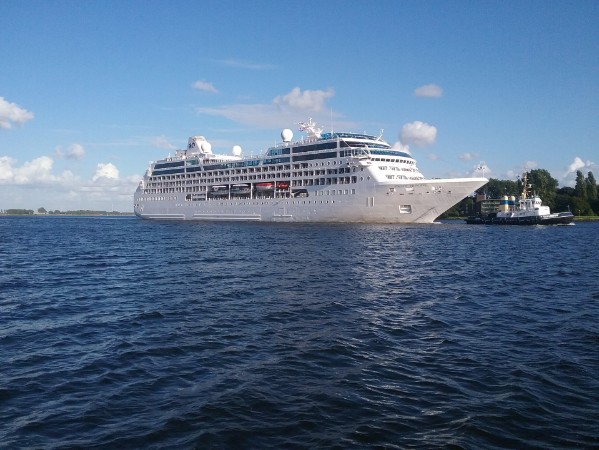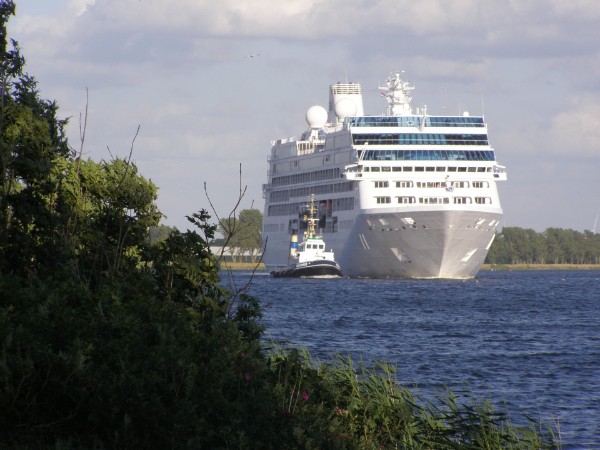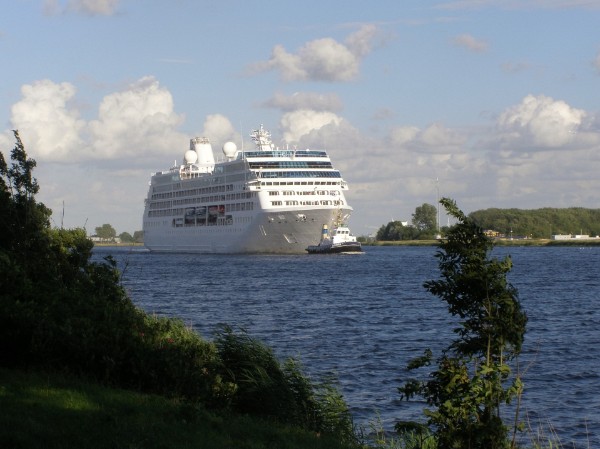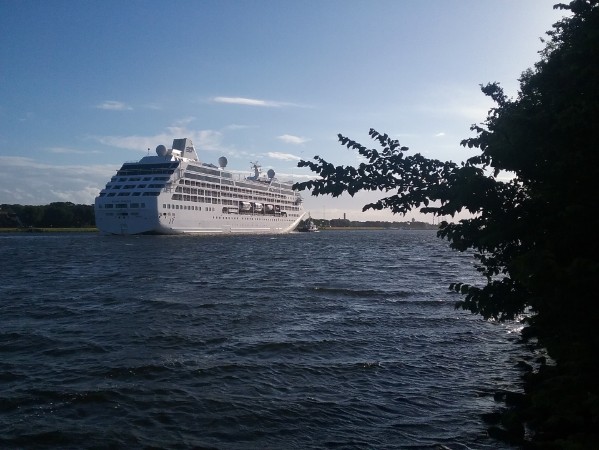Pacific Princess (II)

Pacific Princess, the second ship with this name, sailed past Velsen Noord at the 2nd of july 2016, after her first visit to Amsterdam.
Background
Renaissance Cruises sailed with a series of eight small cruiseliners throughout the 1990's after that company had been formed by Fearley & Eger in 1989. These 4200-ton ships sailed in casual-luxury style to mostly ports that were not able to be visited by larger cruiseliners and the passengers also chose this company for that reason. Still, the company decided to change and built again eight replacement ships of 30.000-ton for growth and the first of those ships entered service in july of 1998 under the name of R One. In style, the ships resembled the oceanliners of yesteryear with grand staircases and wood panneling. The older yaught-like ships were phased out of the fleet while the new ships started their sailings. Of the older ships, a few are also featured on the site like the 1990-built Renaissance IV and Renaissance V and the 1991-built Renaissance VI. In rapid succession, the eight new ships entered service, but being bigger they could not enter those smaller ports and a lot of passengers flocked to other lines. Renaissance Cruises came into real financial difficulties and seven months after the last of the new ships had entered service, the company was declared bankrupt at the 25th of september 2001. Sometimes it is said that the attacks in America were the last push, but it seems hard to believe as the companies situation was definitely sealed before that.

Construction and general statistics
The ships of the so called R-class, due to the plain namingsystem Renaissance Cruises had chosen, were built at the famous Chantiers de L'atlantique yards at St.-Nazaire, France. The later Pacific Princess was built as the thirth ship in line under the name R Three. She had followed R One and R Two, both introduced in 1998. After her, R Four, R Five, R Six, R Seven and R Eight followed between 1999 and 2001. The ships have a tonnage-measurement of 30.277 and with that they were small for modern standards, but still around five-and-a-half times larger then the previous ships within the fleet. Their lenght was 181 meters, they had a width of 25,46 meters and their draft was 6 meters. Propelled by two screws that were driven by four 12-cylinder diesel engines of Wärtsilä design, they were capable of sailing at 20 knots maximum although the normal servicespeed was 18 knots. Power was provided by four generators that were connected to two electric motors. Passengercapacity was 706 maximum and based on two-per-cabin the number given was 684. Also, 372 crewmembers were aboard. Built as yardnumber N31, R Three was floated out of the dock at the 12th of may 1999 and after fitting out, she was delivered to Renaissance Cruises at the following 28th of july.
Design and style
Responsible for the interiour as well as exteriour design of all ships within the class was the Scottish architect John McNeece. Maybe not well-known to everyone, but certainly not new to cruiseship design as he was involved in the design of around 40 cruiseships, including Sovereign Of The Seas, Oriana, Queen Elizabeth 2, The World and Horizon. He created a ship in the style of an old English estate, with extensive use of dark woords, marble and cast-iron ornaments. Very traditional in style and often referring to the classic oceanliners of the 1920's. Colours used were mainly cream, black and bordeaux, finished with many classic artworks and traditional carpeting. The ship was designed as an adult-only ship, like all in the fleet, but simply because there were no children facilities added. Children were not really banned, but simply not adding anything for them meant that no-one would take them anyway. This created a very relaxed atmosphere. Also, the same way as with the children-policy, smoking was not officially forbidden, but simply the passengers were advised not to smoke and so a totally smoke-free ship was created without banning and when you were caught smoking, you were not thrown off the ship also. But because of this 'advice', nobody seemed to smoke aboard and so Renaissance Cruises was the first company with a totally smoke-free fleet. The ship offered three restaurants, next to a buffetrestaurant and an outdoor barbeque. Central place was the two-deck high atrium, topped with a glass dome.
Although very luxury in appearance, the company didn't have formal nights and passengers were not 'advised' to wear tuxedo's or evening gowns aboard. Even the crew was not wearing stripes to underline the casual, informal policy.

Renaissance Cruises
Renaissance Cruises was most active in three regions. R One, R Two and R Five were sailing Mediterranean cruises, R Three and R Four were employed in the Pacific Ocean around Tahiti, R Six sailed worldwide cruises and R Seven and R Eight were built for European cruises. R Three started her Pacific sailings from Papeete, Tahiti in december of 1999 and she started to visit the tropical South Pacific islands together with her slightly younger sister. But Renaissance Cruises itself was sailing into bad weather and declared bankrupt due to their financial position at the 25th of september 2001. Of course their financials had been bad for a longer time, but the forecasts only became worse due to the attacks in America and the beginning of the higher tensions world-wide. The travelbusiness declined sharply and just after the bankrupcy was declared, R Three and R Four were arrested at Uturoa. The ships were reposessed by the builders, who created a company named CruiseInvest under which the ownership of the ships was placed with homeports in Majuro, the Marshall Islands. The meaning was to charter out the still very new ships to other cruiselines but because the uncertaincy the world had been facing since the september 11th attacks, it proved not so simple to find charters.

Princess Cruises
But throughout 2002 and 2003, several companies seemed interested to give a modern alternative in their fleet to the megaships that were already in the planning stages. One of those companies was the mighty P&O Princess combine. They always had been sailing with several smaller ships next to the megaliners and because they phased out the older smaller liners like Island Princess in 1999 and Pacific Princess in 2002, these modern ships could be perfect for them. With Renaissance Cruises now gone from Tahiti, Princess Cruises took over the R Three and R Four in october of 2002 and planned to bring them back under the names of Pacific Princess and Tahitian Princess and had them sail in the region they were originally intended for. After a slight rebuilding, the second Pacific Princess sailed her first cruise departing from Sydney, Australia to Tahiti and the south-Pacific islands. It was a good move to bring back the name of one of the most beloved ships within the company and also name them apropriately for the region they sailed in. But tourism to far-away parts of the world were still not very easy to sell and two ships in the far Pacific was a little too optimistic. From 2006 onwards, Tahitian Princess was taken out of Pacific service and started to sail more world-wide itineraries, later re-named Ocean Princess to reflect her now different role.
Pacific Princess kept sailing mostly the Pacific ocean but was registered at Gibraltar after she had been aquired by Princess Cruises in 2004 from CruiseInvest. From 2006 onwards, the homeport of the ship was again changed to Hamilton, Bermuda, the standard homeport now for the ships within the fleets of Princess Cruises and P&O Cruises. Meanwhile, P&O had also chartered the R Eight in 2003 for the Swan Hellenic brand and she was also placed in the Princess Cruises fleet after the dismantling of this brand in 2007. She recieved the name Royal Princess, but this wasn't taken well by Princess Cruises fanatics who liked to see the name of the former flagship given to a more iconic ship. This happened in 2013, when a thirth Royal Princess entered the fleet and the former Renaissance ship had been re-placed in the P&O fleet as the second Adonia.

With also Ocean Princess sold to Oceania Cruises as their Sirena in 2016, the Pacific Princess now is the only former Renaissance Cruises ship in the Princess Cruises fleet. But also she was not only limited now to the south Pacific, as she was also seen in Europe from 2016 onwards. With now a huge program of large newbuildings for Princess Cruises, it seems she is the only ship retaining the small-ship tradition for the company.
In june of 2017, the ship had a major update and refresh. More light colouring was added to the ships public spaces, not loosing her classic and rich touches from her days as a Renaissance Cruises ship. The restaurants, staterooms and pooldeck were also updated and slightly modernized. Also, the ship recieved Princess Cruises' new form of hullart (yeah, they too) with the Princess blowing hair now also present on the bow. Her first cruise after her update started in Fort Lauderdale at the 9th of june 2017 and took her to London for a series of summer European Cruises.

